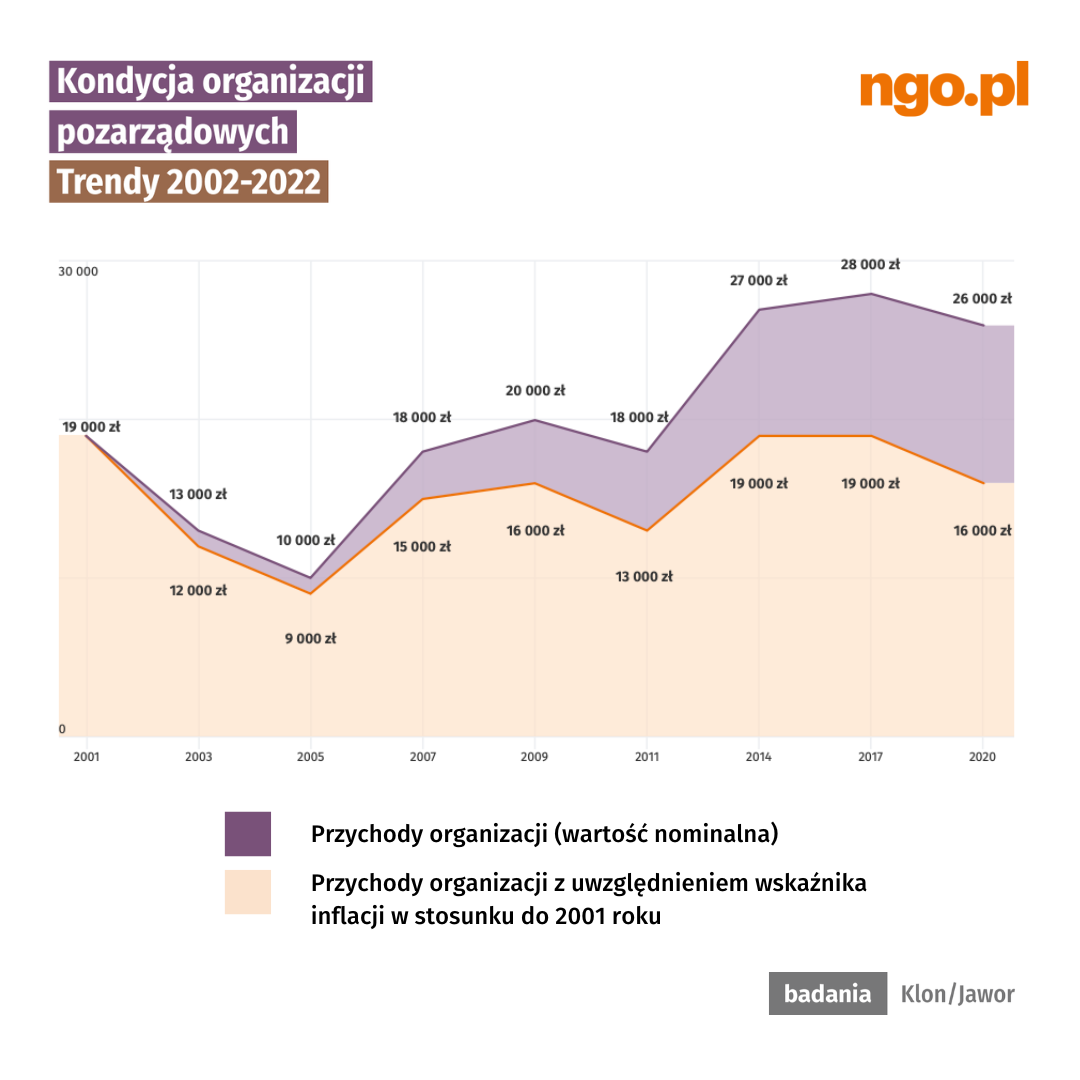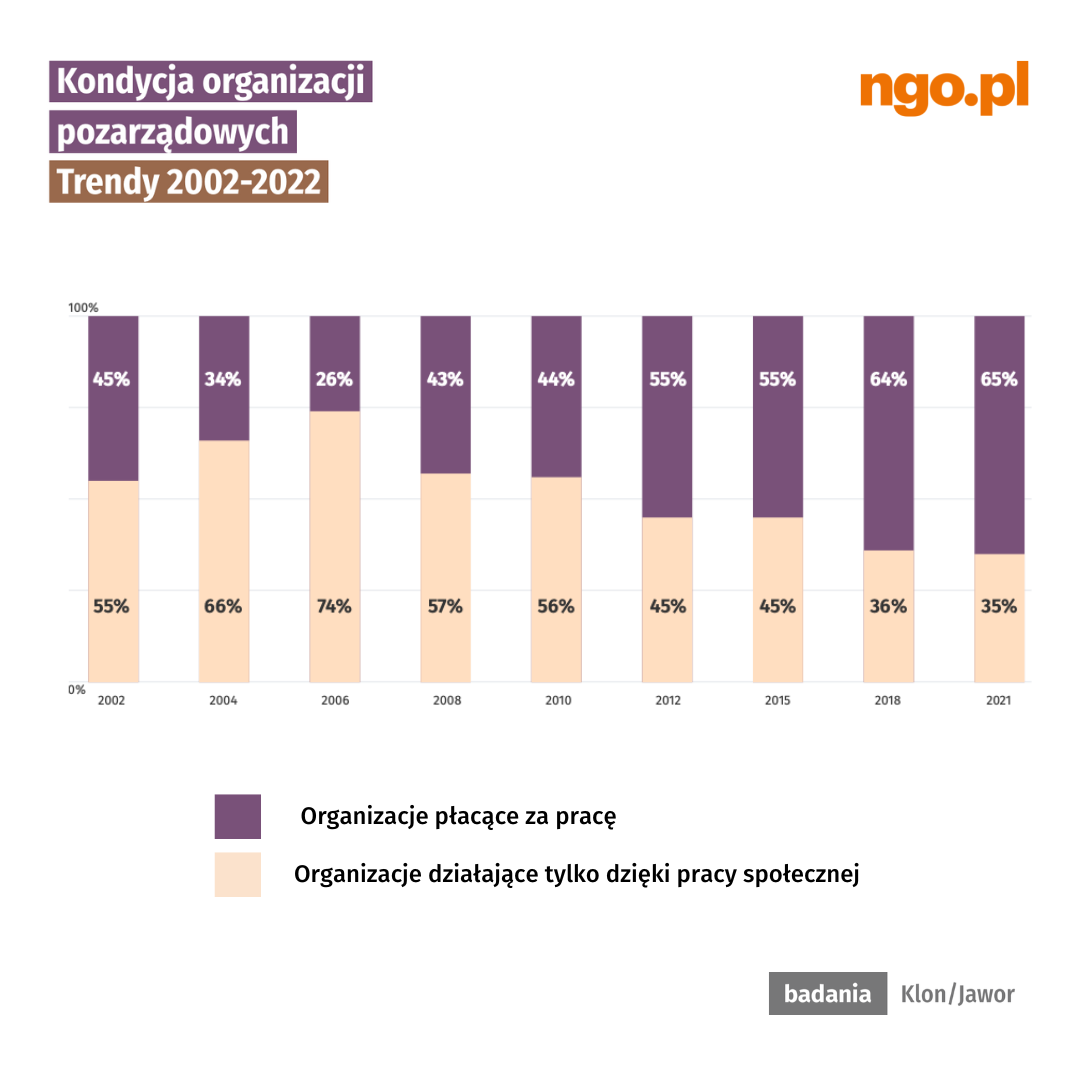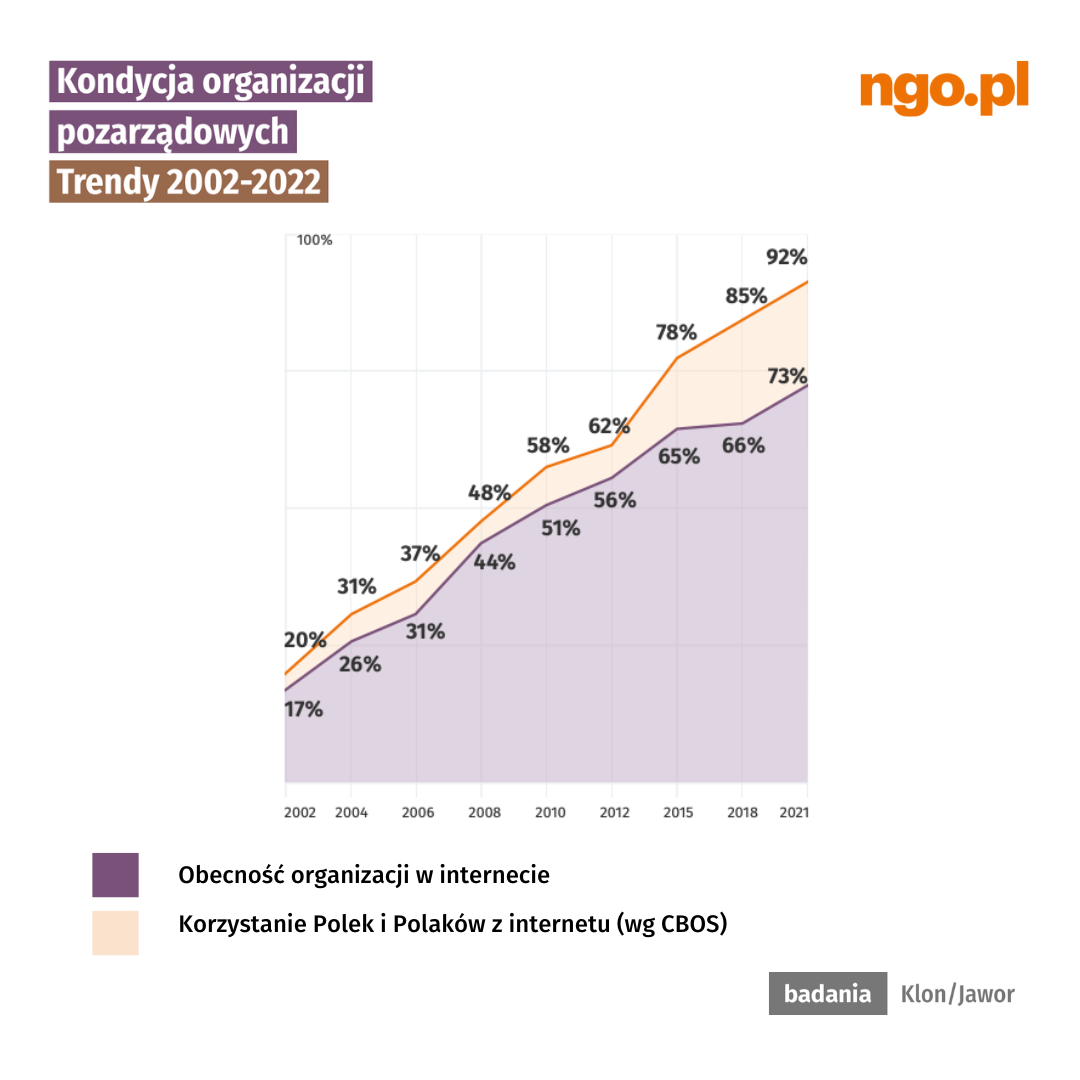Bezpłatny kurs: Jak stworzyć budżet projektu społecznego Zanim wyślesz wniosek o dotację – obejrzyj >
Under the magnifying glass. Has there been a change? 4 trends in the NGO sector
Comparing Poland in the early 2000s to present-day Poland, can show two different countries, and the way Poland has come in these two decades. How has the social sector changed during this period? Here, we discuss the crucial changes.
The Condition of NGOs. Trends 2002-2022" is a summary of 20 years of research on the social sector. In 2002, the Klon/Jawor Association launched a research project to collect and disseminate up-to-date data on the condition of associations and foundations in Poland. 20 years and nine editions of the "Condition of Non-Governmental Organizations" survey later, we bring you a summary of the knowledge gathered in this project about the trends that have shaped the Polish social sector over two decades.
We discuss four pivotal changes.
1. Average revenues of associations and foundations have increased… but not in terms of their purchasing power
The first question regarding the condition of the NGO sector in Poland is about the organizations' wealth. Changes in the financial situation of associations and foundations can be assessed on the basis of the value of the organization's average revenues in a given year. Average revenues - i.e. the median, middle value means that half of the organizations had revenues below this value in a given year, and the other half - above.
A comparison of the nominal value of NGOs' average revenues over the past 20 years, or more precisely between 2001 and 2020, for which the data was collected, shows a gradual increase in revenues (with a slight halt in the upward trend in 2003-2007, as well as in 2011 and 2020). However, comparing the nominal value of revenues does not suffice: what is missing is the information about the change in the purchasing power of money in Poland during this period.
As it turns out, taking into account the inflation rate (calculated relative to the price level of 2001) undermines the thesis of the organizations' revenue growth.
The level of the organization's real revenues has not increased since 2001, remaining at a similar level at best, or even declining at times (between 2003 and 2011, and then in 2020).
It can be said that the real revenue of NGOs in Poland in 2001 was PLN 19 000, while the latest measurement indicates that the NGOs real median revenue in 2020 amounted to… PLN 16 000. So today NGOs are less financially prosperous than they were twenty years ago.
Such a simple indicator as the NGOs' median income makes it easy to assess the change in the financial situation of an organization, but it does not take into account the variation of income within the sector, so it is worth supplementing it with data on the structure of income in a given year.
2. More and more paid labor in NGOs
NGOs are associated with the social, unpaid involvement of activists. However, in addition to social work, the organizations also employ paid labor. Looking at a long, 20-year time frame, we see a change in the nature in which organizations engage people to work and to act for associations or foundations. Over time, the group of organizations that pay for labor is increasing, while the percentage of organizations that operate solely through unpaid, community labor is decreasing.
It is worth noting at this point that by organizations paying for labor we mean here such entities that pay at least one person, regardless of the form of employment and working hours.
In 2002, 55% of associations and foundations did not pay at all for work performed for the organization. In the following years, the group of these organizations expanded to reach a record high in 2006, when 74%, or almost three-quarters of NGOs, operated solely on the basis of unpaid commitment of people.
In the following years, we have seen a gradual reversal of the proportion between organizations that pay for work and those that do not. According to the latest data, in 2021, organizations that operated solely on the basis of community service were 35% (the lowest in the history of our research), which means that almost two out of three organizations offer financial remuneration for labor.
3. Formal challenges increasingly challenging
What are the main challenges that Polish organizations face in their activities? We seek answers to this question in each edition of the "Condition of NGOs" survey. Since 2002, the problem most frequently experienced by organizations is the difficulty in acquiring funds or equipment necessary for the operation of the organization. The fact that ensuring material functioning is the primary problem of NGOs in Poland is not surprising in the context of the declining purchasing power of the average social organization, as discussed above.
However, we would like to draw attention to another category in the infamous ranking of an organization's challenges, i.e. formal challenges. Problems with complicated formalities when using grants, extensive bureaucracy, and excessive government control are on the rise. These problems have been more and more vexing since 2002, and the issue has particularly intensified in the last five years.
Organizations are experiencing more and more formal and legal burdens, which are increasing every year. Just a few years ago, the most important formal aspect was accounting and taxes, but now organizations are also burdened with other responsibilities: creating a concept for protecting personal data, filing documents digitally, learning new tools for billing, or understanding complex laws. Such a trend, while sad, is again, unfortunately, not surprising.
4. Digital revolution in NGOs
To end on a positive note: the use of the Internet by organizations to communicate with the public is growing rapidly. Between 2002 and 2021, the percentage of organizations with an online presence has increased 4.5 times - from 20% to over 90%. The growing trend of NGOs' online presence (meaning that the organization has a website or some other type of its business card on the web) runs parallel to the increasing access to and use of the Internet by the entire population, as well as the development and more frequent use of various types of online applications.
Until 2010, an organization's online presence primarily meant having a website. Figures from 2012 show the rise of social media: that year, 24% of organizations have declared using social media to communicate about their activities. Later, the use of social media to communicate with the public gradually increased.
In 2021, more associations and foundations had a social media profile than their own website.
In 2020-2021, the operating conditions of the pandemic have only solidified the role that the Internet plays in the organization's activities. At the same time, the pandemic showed that not every activity can be carried out online, even at the cost of suspending operations (half of the organizations suspended a significant part of their activities for at least six months for this reason).



